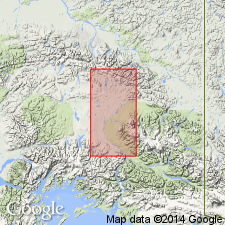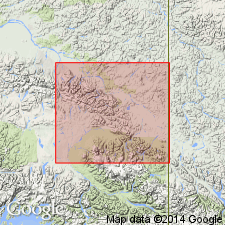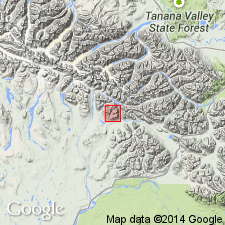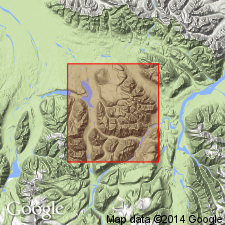
- Usage in publication:
-
- Mankomen formation*
- Modifications:
-
- Named
- Biostratigraphic dating
- Dominant lithology:
-
- Sandstone
- Shale
- Limestone
- AAPG geologic province:
-
- Alaska Southern region
Summary:
Lies north of Mankomen Valley and Mankomen Lake, central Copper River region, southern AK. Consists of series of sandstones, shales, and limestones with intrusive sheets with total thickness between 6000 and 7000 ft. A 6700-ft columnar section is given. Abundant fossils identified by Charles Schuchert establishes age as Permian.
Source: GNU records (USGS DDS-6; Menlo GNULEX).

- Usage in publication:
-
- Mankomen formation*
- Modifications:
-
- Overview
- AAPG geologic province:
-
- Alaska Southern region
Summary:
Type locality of Mankomen formation of Mendenhall (1905) is interpreted to be in upper Chistochina valley, north of Mankomen Lake, in central Copper River region, southern AK, although section is not typical of Permian beds in Chisana-White River district. Stratigraphic section at type locality is dominantly of lime deposition and is not duplicated elsewhere. Mankomen is described in some detail in report.
Source: GNU records (USGS DDS-6; Menlo GNULEX).

- Usage in publication:
-
- Mankomen Group*
- Modifications:
-
- Revised
- Age modified
- Biostratigraphic dating
- AAPG geologic province:
-
- Alaska Southern region
Summary:
Mankomen Formation of Mendenhall (1905) is raised in rank to Mankomen Group. Includes two new formations (ascending): Slana Spur Formation (4550 ft thick of volcaniclastic and calcareous volcaniclastic rocks) and Eagle Creek Formation (2940 ft thick of nonvolcanogenic marine argillite and limestone). Group conformably overlies Tetelna Volcanics of Pennsylvanian(?) age. Unconformably underlies Nikolai Greenstone of Middle and (or) Late Triassic age. Intruded by abundant dikes, sills, and small stocks. Fossils indicate Slana Spur Formation is Middle Pennsylvanian to Early Permian in age; Eagle Creek is entirely of Early Permian age.
Source: GNU records (USGS DDS-6; Menlo GNULEX).

- Usage in publication:
-
- Mankomen Group*
- Modifications:
-
- Biostratigraphic dating
- AAPG geologic province:
-
- Alaska Southern region
Summary:
Age of Mankomen Group, locally, shown on Nabesna B-5 quad as Early Permian on basis of cephalopods, brachiopods, and corals. [No mention is made of Slana Spur or Eagle Creek Formations which are part of group.]
Source: GNU records (USGS DDS-6; Menlo GNULEX).
For more information, please contact Nancy Stamm, Geologic Names Committee Secretary.
Asterisk (*) indicates published by U.S. Geological Survey authors.
"No current usage" (†) implies that a name has been abandoned or has fallen into disuse. Former usage and, if known, replacement name given in parentheses ( ).
Slash (/) indicates name conflicts with nomenclatural guidelines (CSN, 1933; ACSN, 1961, 1970; NACSN, 1983, 2005, 2021). May be explained within brackets ([ ]).

